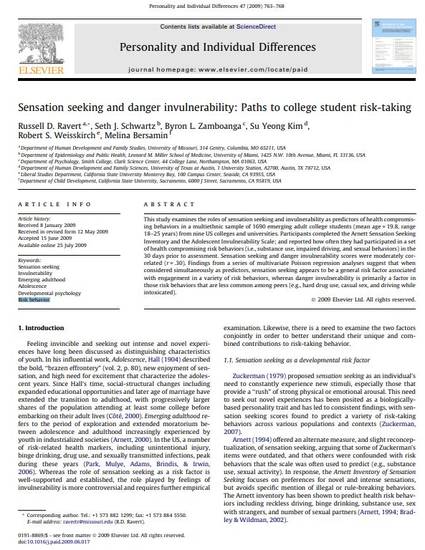
Article
Sensation seeking and danger invulnerability: Paths to college student risk-taking
Personality and Individual Differences
(2009)
Abstract
This study examines the roles of sensation seeking and invulnerability as predictors of health compromising behaviors in a multiethnic sample of 1690 emerging adult college students (mean age = 19.8, range 18–25 years) from nine US colleges and universities. Participants completed the Arnett Sensation Seeking Inventory and the Adolescent Invulnerability Scale; and reported how often they had participated in a set of health compromising risk behaviors (i.e., substance use, impaired driving, and sexual behaviors) in the 30 days prior to assessment. Sensation seeking and danger invulnerability scores were moderately correlated (r = .30). Findings from a series of multivariate Poisson regression analyses suggest that when considered simultaneously as predictors, sensation seeking appears to be a general risk factor associated with engagement in a variety of risk behaviors, whereas danger invulnerability is primarily a factor in those risk behaviors that are less common among peers (e.g., hard drug use, casual sex, and driving while intoxicated).
Keywords
- Sensation seeking,
- Invulnerability,
- Emerging adulthood,
- Adolescence,
- Developmental psychology,
- Risk behavior
Disciplines
Publication Date
2009
DOI
10.1016/j.paid.2009.06.017
Citation Information
Russell D. Ravert, Seth J. Schwartz, Byron L. Zamboanga, Su Yeong Kim, et al.. "Sensation seeking and danger invulnerability: Paths to college student risk-taking" Personality and Individual Differences Vol. 47 Iss. 7 (2009) p. 763 - 768 Available at: http://works.bepress.com/rob-weisskirch/26/
